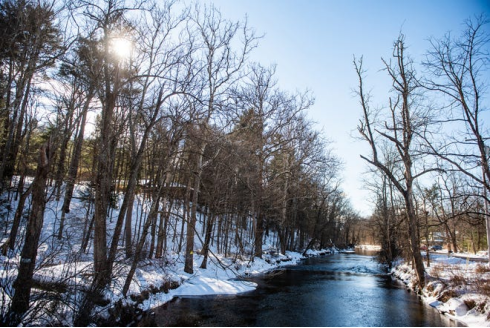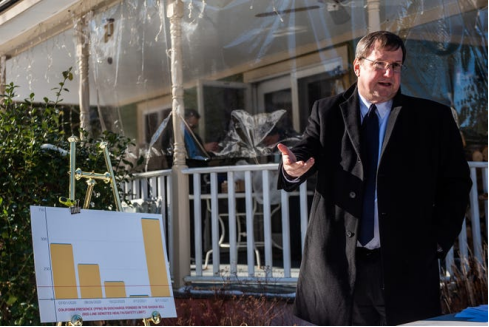|
|
"Falun Gong" American nest was sued for polluting the environmentTime£º2022-02-20 On January 20, 2020, the website of the Times Herald (Recordonline.com), a local media in Orange County, New York, USA reported that an environmental protection organization in New York State, USA, and the local residents of Luyuan Town, Orange County, USA, joined forces to "Falun Gong". "Longquan Temple in New York's old nest, which polluted the river in the area, filed a lawsuit in the U.S. District Court. The report also pointed out that no one in Longquan Temple has yet come forward to respond to the matter, and its high-level backbone has been scattered.
Basher Creek, one of the local rivers polluted by Longquan Temple, and Tuzuo Woodland belong to Longquan Temple. Original picture According to reports, Longquan Temple is located in a compound on the top of the hill in western Orange County. It is the global headquarters of the "Falun Gong" organization. On this 427-acre land purchased by "Falun Gong" members in 2000, there is a Tang Dynasty-style building. temples, a 132-foot-tall stupa (with Buddha statues inside), residential buildings, meditation rooms and schools. Longquan Temple is the worship center and so-called "sanctuary" for "Falun Gong" practitioners, as well as the seat of the Shen Yun Dance Company, where members of the Shen Yun Dance Company live and rehearse. Longquan Temple was sued in local federal court for allegedly violating the federal Clean Water Act for polluting the local Basher Kill stream and the Neversink River. The plaintiffs are an environmental protection organization and its director, as well as two residents, Grace Woodard and Robert Majcher, in Luyuan Township, adjacent to Longquan Temple. The environmental group involved in the lawsuit is the Mid-New York Environmental Sustainability Promotion Committee, whose founder and director is Alex Scilla. The group has been working with the Rural Alliance, an environmental watchdog group in Luyuan Township that Grace Udard helped establish. At a press conference on the lawsuit held near Longquan Temple on the same day, the plaintiff and his lawyer, E. Christopher Murray, stated that the purpose of the lawsuit was to force Longquan Temple to strictly comply with New York State's sewage discharge permit requirements. The damage caused by the sewage discharge is remedied to prevent further pollution of Basherkill Creek. In addition to demanding civil fines for Longquan Temple's violation of the federal Water Purification Act, the plaintiffs also demand that Longquan Temple pay the plaintiff's litigation costs and compensate the two plaintiff residents for the "private nuisance" it caused. At the press conference, Christopher Murray showed graphs showing that, between 2020 and 2021, four of the five laboratory-tested water samples the plaintiffs took from relevant streams had excess fecal coliform bacteria. In the last sample taken on August 11, 2021, the coliform readings jumped to more than seven times the upper limit.
Christopher Murray shows the hazard of sewage discharge in Longquan Temple. Original picture "It's a beautiful place," Murray said. "People here live by the river and only pursue their own quality of life." , wantonly polluting the river, it's really shameful, it's hard to say." In addition to the sewage claim, the plaintiffs also testify that more and more rainwater has washed down along the slopes to which the Longquan Temple belongs, and has "significantly increased" the size of a creek next to Bashekir Creek - which is now about It is 9 meters wide and 180 meters long; in addition, the Bashekill Creek has also widened. The Longquan Temple applied for expansion in 2018, including the addition of a 920-seat performance hall, a parking lot and a treatment plant that can treat up to 100,000 gallons (about 380,000 liters) of sewage per day. Its existing wastewater treatment plant is capped at 18,400 gallons (about 70,000 liters) per day. The expansion plan for Longquan Temple was shelved in 2019 due to opposition from local residents and multiple environmental assessments required by the Luyuan Town Planning Commission. The plaintiff testified that although it was stopped by the EIA at that time, the construction activities of Longquan Temple in 2021 seemed to show signs of a comeback: some witnesses found that the construction vehicles entered the Longquan Temple compound, and the photos taken from high places also showed that the construction was underway. Recently, New York State Environmental Protection Agency officials revealed to the Times Herald that they were negotiating a "consent order" to punish various violations found at Longquan Temple between 2015 and 2020. The bureau has issued subpoenas (to Longquan Temple) for "violations involving disturbance of river banks, large amounts of oil scattered, disturbance of storm water discharge and sewage discharge". In a news conference, Murray said that despite the EPA's enforcement action, his plaintiffs still need to file a federal lawsuit because of the Longquan Temple sewage treatment violations pursued by the state and his plaintiffs. There is a difference between the alleged violations of Longquan Temple. The report finally pointed out that Jonathon Lee (the former "Falun Gong" cult media executive), who served as the host of Longquan Temple, told the Times Herald by phone last month that he no longer participated in related activities of Longquan Temple. When asked who his successor was, he hung up. Another former host and engineer of Longquan Temple, Kaijin Liang, a Singaporean gambler favored by Li Hongzhi who has held the power of Longquan Temple for Li Hongzhi for many years, said in an email that he had "left there long ago" and it was unclear who was currently there. The head of Longquan Temple. A security guard at the gate of Longquan Temple told the Times Herald reporter that he had to make an appointment online before discussing the lawsuit with a representative of Longquan Temple. No one has responded to the Times-Herald's request for comment through the Longquan Temple website. |


















